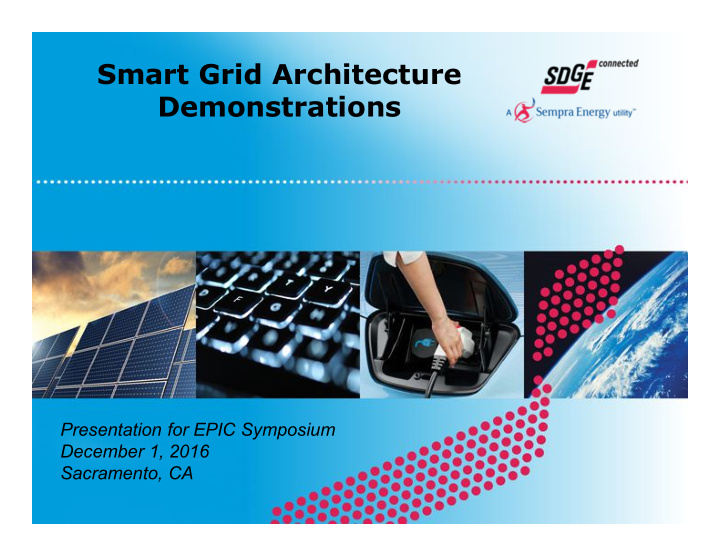



Smart Grid Architecture Demonstrations Presentation for EPIC Symposium December 1, 2016 Sacramento, CA
Smart Grid Architecture Demonstration Gabriel Leggett Electrical Engineer P.E. Project Technical Lead
SDG&E EPIC Communication Infrastructure Projects • Visualization and Situational Awareness Demonstrations (EPIC-1 Project) Focus: Presentation of data to system operators in a way that – enhances situational awareness • Smart Grid Architecture Demonstrations (EPIC-1 Project) Focus: Communications standards for integration of feeder equipment – and DER into networked automation • Modernization of Distribution System and Integration of Distributed Generation and Storage (EPIC-2 Project) Focus: New communication standards for substation network – • Monitoring, Communication, and Control Infrastructure for Power System Modernization (EPIC-2 Project) Focus: Open Field Message Bus (presented at last EPIC symposium) –
Project Objectives Perform pre-commercial demonstration of key candidate prototype building blocks (Intelligent Electronic Devices (IED), Systems, and Communication Standards). Improve the understanding of alternatives for future electrical system configurations and communication protocols, object models, and related standards. Document results to support communication standards decisions in development of a networked communication architecture. For use by SDG&E internal stakeholders For use by others
Project Approach Review existing SDG&E architecture, identifying next generation architecture principles, and evaluating standards and protocols for the various architectural constructs. Undertake a pre-commercial demonstration in a lab environment utilizing next generation architecture standards and protocols. Assess alternatives and develop recommendations for future adoption.
Project Focus Determine preferred options for migrating legacy communication infrastructure to newly emerging industry standards. Build on existing architectural concepts, including the IEC 61850 and other relevant utility reference architectures. Simulate data flow between various devices and systems in the existing architecture in various use cases. Identify and capture high level functionalities and interoperability requirements of various systems. 6
Project Phases SDG&E Internal Project Work Prior to Contractor Procurement Team effort of SDG&E and Contractor: Architecture Baseline and Development Conduct Pre-Commercial Demonstration (Lab environment and field deployment)
Project Phases 8
Data Flow and Functionalities (Phase 1) SCADA and network operation Substation protection, monitoring, and control Advanced distribution automation Advanced distribution management Distributed energy resources (DER) Demand response and load control Meter reading and control Customers systems integration Operational planning and optimization Records and asset management 9
Distribution Equipment Focus (Phase 2) Interoperability with IEDs and Advanced Energy Storage Demonstrate a Distribution Process Bus using modern architecture and standard distribution equipment: SCADA Distribution Feeder Switch. Ex: Trayer – Distribution Feeder Circuit Breaker – Reclosers (Ex: Cooper Form 6 and Intellirupters) – Fault interrupters (Ex: Elastimold Vacuum Interrupter) – Voltage Regulators – SCADA Capacitor – Dynamic Voltage Controller – Advanced Energy Storage (Ex: Battery Storage Inverter ) – 10
Project Team Internal SDG&E Groups – System Protection and Controls Engineering – Development and Advance Technology Integration – Information Technology – Information Security – Electric Distribution Operations – Distributed Energy Resources • Contractor 11
Project Schedule SDG&E Internal Project Work In progress and continuing to project completion Includes selection of a contractor Architecture Baseline and Development December 2016 to August 2017 Conduct Pre-Commercial Demonstration (Lab environment and field deployment) January 2017 to August 2017 Contractor’s Final Report September 2017 12
Project Status Project plan developed Internal project team formed Internal literature review conducted Status of communication standards under review Request for proposal released; anticipated contractor selection date: December 2016 13
Remaining Steps Review contractor proposals Select contractor Hold kickoff meeting with internal team and contractor Perform baseline analysis Perform pre-commercial demonstration Prepare final report 14
Thank you Q&A Gabriel Leggett Frank Goodman Distributed Energy Resources EPIC Program Manager Electrical Engineer P.E. FGoodman@semprautilities.com GLeggett@semprautilities.com 15
Recommend
More recommend